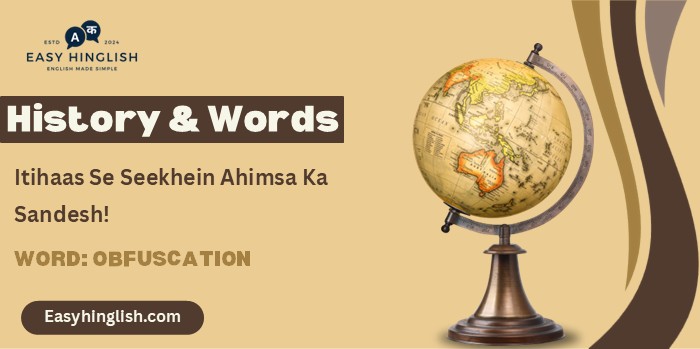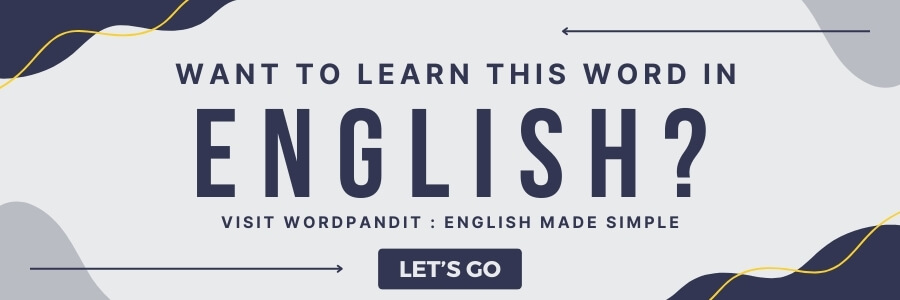History & Words: ‘Obfuscation’ (4 June)
Welcome to ‘History & Words’! 🌟 Main hoon Prashant, Wordpandit aur Learning Inc. Network ka founder. Yeh series language learning aur historical context ko connect karti hai, taaki vocabulary improve ho aur history ki understanding bhi deep ho.
Chaliye, shabdon ki iss journey par mere saath chaliye aur naye naye words explore karte hain! 😊
📚 Table of Contents
🔍 Word of the Day: Obfuscation
Pronunciation: /ˈɒbfʌskeɪʃən/ (ob-fuh-skay-shun)
🌍 Parichay (Introduction)
4 June 1989 ek aisa din tha jab Beijing ke Tiananmen Square me thousands of protestors ne democracy, freedom, aur reform ki maang karte hue shanti se protest kiya. Lekin raat ke andhere me un protestors par military crackdown hua, jisme anek logon ki jaan gayi.
Is tragic event ke turant baad Chinese state media ne shuru ki ek deliberate campaign—Obfuscation ki. Yaani truth ko dhundhla kar dena, facts ko distort karna, aur ek aisi narrative banana jo reality se alag ho.
Aaj ke digital aur post-truth era me obfuscation ek powerful aur dangerous tool hai—jo history, facts aur public memory ko manipulate karta hai.
🌱 Shabd ka Utpatti (Etymology)
“Obfuscation” bana hai:
- Latin: ‘obfuscare’ – jiska matlab hota hai “to darken” ya “to obscure.”
- ob- = over, against
- fuscare = to darken
English me iska use 16th century se ho raha hai, especially jab deliberate confusion create karne ki baat hoti hai—legal, political, ya psychological contexts me.
📖 Mahatvapurn Shabdavali (Key Vocabulary)
- 🔑 Censorship: Information ya ideas ko control ya suppress karna.
- 🔑 Disinformation: Galat jaankari jo jaan bujhkar phelaayi jati hai.
- 🔑 Propaganda: Government ya powerful group dwara chalayi gayi biased campaign.
- 🔑 Narrative Control: Public perception ko manipulate karne ki strategy.
- 🔑 Memory Hole: Orwellian term jahan uncomfortable truths systematically erase kiye jaate hain.
🏛️ Itihasik Sandarbh (Historical Context)
1989 me China me students aur citizens ne Tiananmen Square par ikattha hokar government accountability aur democracy ki maang ki.
- 15 April se protests shuru hue, aur dheere dheere national movement ban gaya.
- 3-4 June ki raat Chinese military ne tanks aur troops ke saath crackdown launch kiya.
- Dozens, ya shayad hundreds ya thousands log mare gaye—lekin exact numbers kabhi confirm nahi hue.
Iske turant baad Chinese state ne poori duniya ke saamne ek systematic campaign of obfuscation shuru ki:
- Photos aur video evidence erase kiya gaya.
- Local media me kuch bhi mention nahi kiya gaya.
- Protestors ko “rioters” declare kiya gaya.
- International reporting par strict censorship lagayi gayi.
Yeh classic case tha obfuscation ka—jab truth ko bury kar diya gaya aur logon ki collective memory ko rewire kiya gaya.
⏳ Samayrekha (Timeline)
- 15 April 1989: Hu Yaobang ki death ke baad students Tiananmen Square par ikattha hote hain.
- May 1989: Lakhs log shanti se protest karte hain Beijing me.
- 3-4 June 1989: Military crackdown; tanks Beijing me march karte hain, civilians par fire khola jata hai.
- 5 June 1989: “Tank Man” photo duniya bhar me resistance ka symbol ban jaata hai.
- June 1989 onwards: Chinese media me complete blackout shuru ho jata hai.
- 1990s–present: Chinese textbooks, internet, aur media me is incident ka koi zikar nahi hota—ek orchestrated obfuscation ke tahat.
🌟 Is Din ka Mahatva (The Day’s Significance)
4 June 1989 ek aisa din tha jahan truth aur suppression ke beech ka takraav hua.
- Is din ne bataya ki kis tarah truth ko bury karne ke liye poore state machinery ka use kiya ja sakta hai.
- Aaj bhi China me is din ke baare me baat karna taboo hai—keywords block hote hain, images delete kar diye jaate hain, aur “Tank Man” photo ko trace bhi nahi kiya ja sakta.
- Internet par keywords jaise “1989,” “June 4,” aur “Tiananmen” censor ho jaate hain.
Yeh sab Obfuscation ka hi hissa hai—jahaan memory ko rewrite kar diya jaata hai, aur truth ko systematically erase kiya jaata hai.
💬 Prasiddh Ukti (Quote)
“The most effective way to destroy people is to deny and obliterate their own understanding of their history.”
— George Orwell
(Matlab: Kisi samudaay ko kamzor karne ka sabse asaan tareeka hai uski history ko distort kar dena.)
🔮 Aaj Ka Matlab aur Chintan (Modern Usage & Reflection)
Aaj ke zamane me Obfuscation har jagah dikhta hai:
- ✅ Political speeches jahan clarity se bachne ke liye confusing language ka use hota hai.
- ✅ Tech companies jo privacy policies ko intentionally complex banate hain.
- ✅ Media narratives jahan selective reporting ya biased framing hoti hai.
- ✅ Corporate scandals jahan facts ko twist karke public ko gumrah kiya jaata hai.
Obfuscation ka matlab sirf jhooth bolna nahi—kabhi kabhi sach ko confuse kar dena hi sabse bada jhooth hota hai.
🏛️ Virast (Legacy)
- ✅ Tiananmen Square protestors ki kurbani duniya bhar ke civil rights movements ko inspire karti rahi hai.
- ✅ Chinese government ka obfuscation model ek case study ban gaya hai authoritarian control ke liye.
- ✅ Free speech aur transparency ke activists ke liye 4 June ek reminder hai—truth ko preserve karna ek moral responsibility hai.
🔍 Tulnatmak Vishleshan (Comparative Analysis)
- 🔁 Obfuscation vs Transparency – Ek confuse karta hai, doosra clarify.
- 🔁 Censorship vs Freedom of Information – Ek silence karta hai, doosra empower.
- 🔁 Historical Accuracy vs State-Controlled Memory – Ek sach ko preserve karta hai, doosra rewrite.
Tiananmen ke baad ka Chinese information model ek monumental case hai ki kaise obfuscation pure ek generation ki soch ko shape kar sakta hai.
💡 Kya Aapko Pata Hai? (Did You Know?)
🎓 Antim Vichar (Conclusion)
Obfuscation ek shabd nahi—ek process hai jahan sach ka gala ghot diya jaata hai. 4 June 1989 ke baad Chinese authorities ne hume dikhaya ki kaise truth ko erase kiya ja sakta hai bina logon ko realize karwaye.
Lekin history ke paas ek apni taqat hoti hai—woh kabhi complete silence me nahi jati. Edward White jaise log intrepidity ka symbol bante hain, aur Tiananmen ke protestors truth ke torchbearers.
Obfuscation ko pehchanna aur usse ladna hi democracy ka pehla kadam hai.
📚 Aage Padhne Ke Liye (Further Reading)
- 📖 The People’s Republic of Amnesia – Louisa Lim
- 📖 Tiananmen Papers – Zhang Liang
- 📖 Orwell’s “1984” – George Orwell
- 📖 On Tyranny – Timothy Snyder
- 📖 Age of Surveillance Capitalism – Shoshana Zuboff








